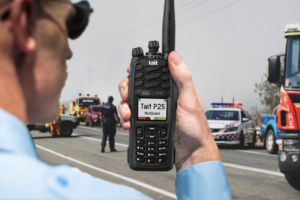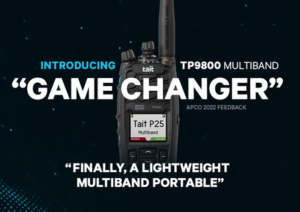Whether you are a beginner or seasoned expert, maximizing your LMR, DMR and P25 knowledge is essential to doing your job well and keeping your users safe. The Tait Radio Academy is a free online school dedicated to providing tutorial content that shares and improves everyone’s radio knowledge. Today we feature the latest addition to our ‘Basic Radio Awareness’ course, ‘What is Multiband Radio?’.
Basic Radio Awareness is taught by Dr. Jan Noordhof, a consultant with over 20 years’ experience in critical communications. He walks through the foundations of critical communications, covering topics like communication, modulation, trunking, propagation, TDMA and FDMA, and more. The Basic Radio Awareness course covers three lessons, several video shorts that explain specific topics.
This new lesson explores:
- The definitions and differences between:
- Multiband
- Dual band
- All band
- Crossband
- Multimode/Multiprotocol
- The important role of a multiband antenna for portable radios
- A range of use cases and benefits for multiband radios
You may have seen the photo of a police officer in a squad car sitting next to several mobile or portable radios. Each radio gives access to a different radio network or frequency band. If this picture could speak, it might say ‘why isn’t there a single radio that can replace all of these?’. Technology has answered this question with the development of multiband radios.
Many public safety radios today are single-band devices. They have been designed and tuned to operate in just one of the following specific frequency bands:
- 66-88MHz (known as VHF mid band)
- 136-175MHz (known as VHF high band, widely used for LMR around the world)
- 200MHz – VHF Band III, used in the United Kingdom
- 300-400MHz – UHF specialist use, eg military
- 380-470MHz (referred to as UHF 1,widely used for LMR around the world)
- 450-520 (referred to as UHF 2, widely used for LMR around the world)
- 700/800MHz (Commonly used in North America)
- 900MHz (Sometimes used in North America)
It is not uncommon for a public safety agency to run networks in two (or three) of these bands e.g. UHF (which has better in-building coverage] plus VHF (which has better range) or VHF plus UHF plus 700/800 MHz. This means that officers who require access to each network may need to be equipped with two (or three) appropriate radios– one for each network. Alternatively, they can have a single multiband radio capable of operating in two or more frequency bands. All in the same unit.
Multiband radios available in the market today typically cover three bands, VHF, UHF, and 700/800MHz.
“All Band” Radios
Some radios in the market are misleadingly described as ‘All-Band’ when, in reality, they operate in several selected bands. “All band” radios typically only cover VHF High band 136-174MHz, UHF 380-520MHz, and 700/800MHz, and typically do not cover other bands such as VHF Mid band 66-88MHz, 200MHz or 900MHz.
Dual Band Radios
Many agencies find that two frequency bands are all they ever need and so refer to their multiband radios as ‘Dual Band’. Australian law enforcement, for instance, is restricted to VHF and UHF bands. A multiband radio can transmit and receive calls on any one of the available frequency bands.

Scanning
Whether single-band or multiband, a radio can be programmed to automatically scan each channel in turn looking for traffic. When activity is detected, the radio locks onto that channel and diverts its audio to the radio’s speaker. Both kinds of radio support a variety of scanning operations (e.g. priority scanning, background scanning, talkgroup scanning etc.). And both allow the scan list of channels be Type 1 multimode e.g. any mixture of analog, P25 conventional, P25 Phase 1 trunking, or P25 Phase 2 trunking.
But where scanning on multiband radios differs is that the scanning can cross frequency bands. The scan list can include channels from any band the radio supports. For example, an agency that has a rural VHF system as well as an urban UHF system, can scan channels from both via the same radio. This capability gives multiband radios enormous operational flexibility.

Roaming
What about operating across systems belonging to different agencies which may need to share communications when an incident arises? (For instance, Fire, Law Enforcement, and EMS responding to a major traffic accident.) In an emergency, radio users need the ability to collaborate by moving seamlessly from the operational area of one system to the operational area of another system – without changing the operating identities (individual and/or group) of the radios. Interoperation across different systems – called roaming – is made a great deal easier with multiband since there is no longer a need to share bands or frequencies to inter-operate. Of course, roaming doesn’t happen by magic. Let’s look at this in a little more detail.
There is a great deal of preliminary work that needs to be done once system owners agree to cooperate. Systems must be configured to identify and authenticate each other and their respective pools of radio units. And radios must be programmed to allow managed access – including scanning access – to neighbouring systems. Nevertheless, no extra infrastructure equipment is required to enable connection to multiple agencies and to allow roaming on their networks in any band. Multiband just makes this easier.
The key is to set up a network of systems that want to interconnect. Each such system is fully independent, administers itself, and has its own id. For the purposes of inter-operation, however, they are all identified as belonging to the same wide area network. This is analogous to the law enforcement agencies of a county that are separate but are identified as belonging to the same county.
The simplest case is the agency that has a rural VHF system as well as an urban UHF system. The two systems are distinguished by their system id. Roaming across these systems is a must for officers of this agency. Now, by identifying both the rural and urban systems as belonging to the same wide area network, roaming is straightforward. So, for roaming to work without additional infrastructure equipment, it doesn’t matter if the systems belong to the same agency or to different agencies, the essential feature is that they share the same wide area communications id.
View the full lesson notes and other courses available for free on Tait Radio Academy!
Next in this series: Why Use Multiband Radios?
 Learn more about the seamless multiband performance and rugged, lightweight design of Tait’s very own TP9800 Multiband Portable Radio
Learn more about the seamless multiband performance and rugged, lightweight design of Tait’s very own TP9800 Multiband Portable Radio
Have a question or query? Contact us.




